牛津译林版(2019)选择性必修 第一册Unit 3 The art of painting Welcome to the unit and Reading课件(共129张PPT)
文档属性
| 名称 | 牛津译林版(2019)选择性必修 第一册Unit 3 The art of painting Welcome to the unit and Reading课件(共129张PPT) |  | |
| 格式 | pptx | ||
| 文件大小 | 17.2MB | ||
| 资源类型 | 教案 | ||
| 版本资源 | 牛津译林版(2019) | ||
| 科目 | 英语 | ||
| 更新时间 | 2024-04-17 21:51:52 | ||
图片预览

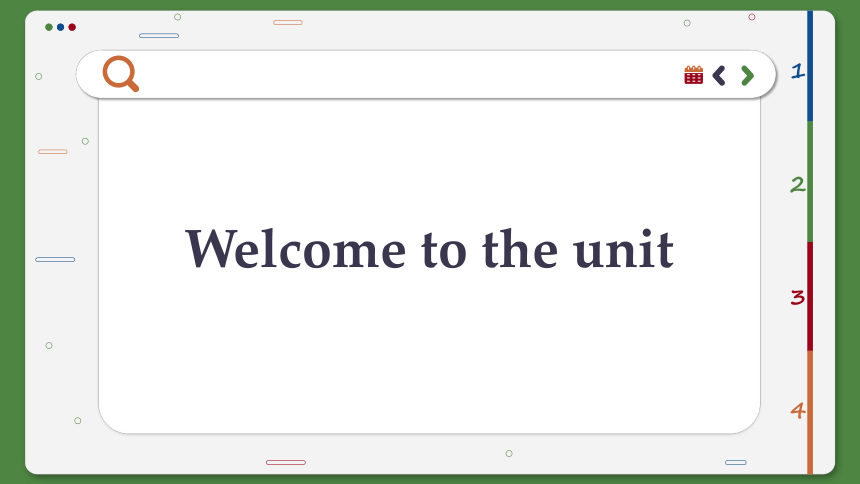

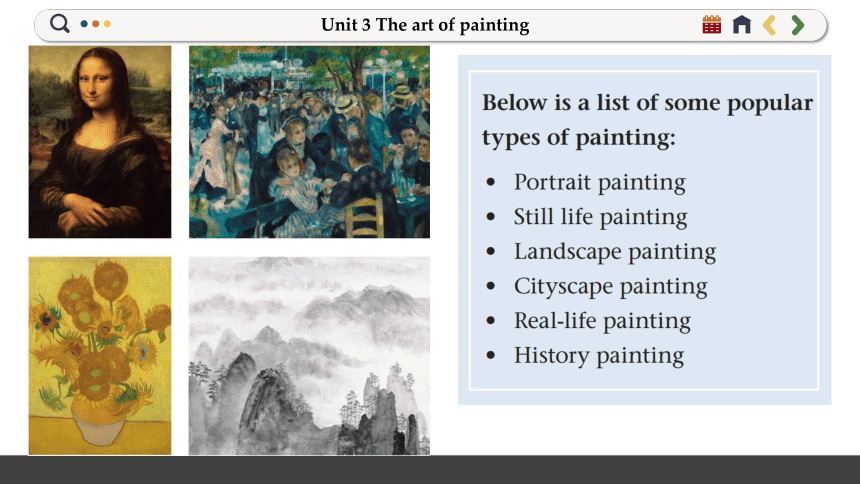
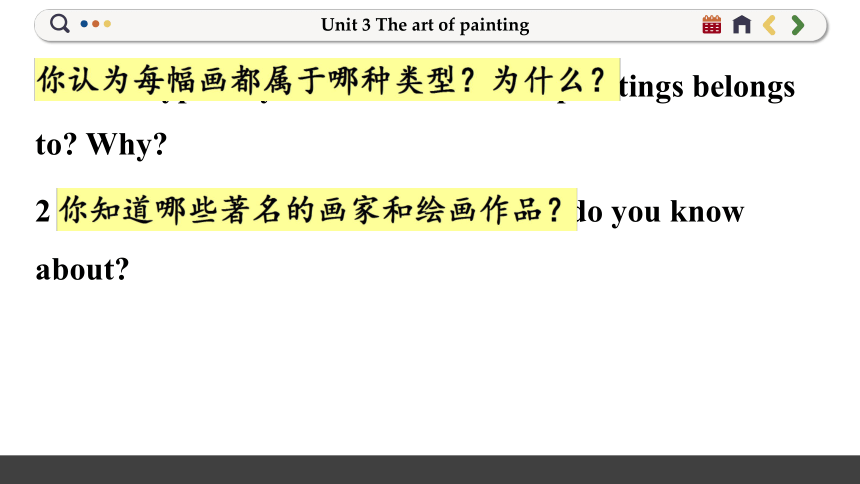
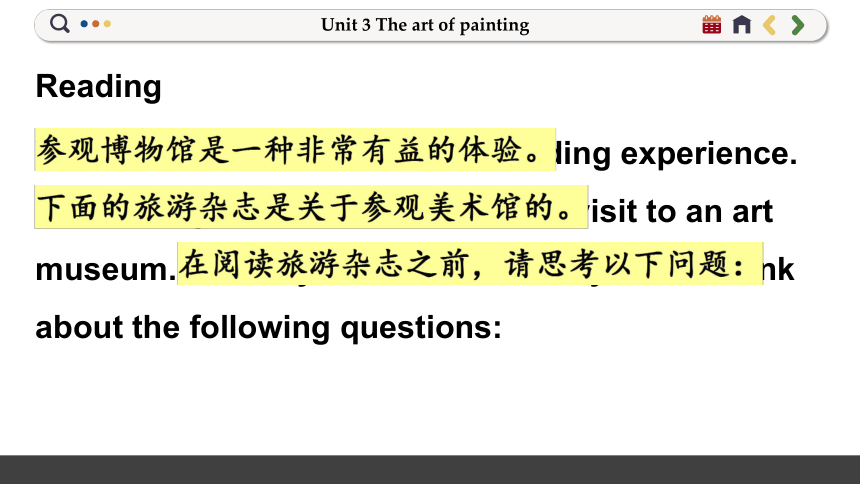
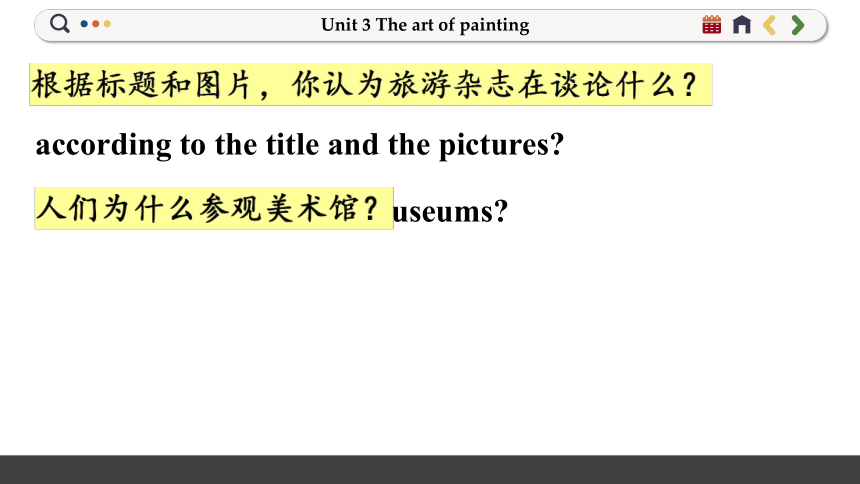
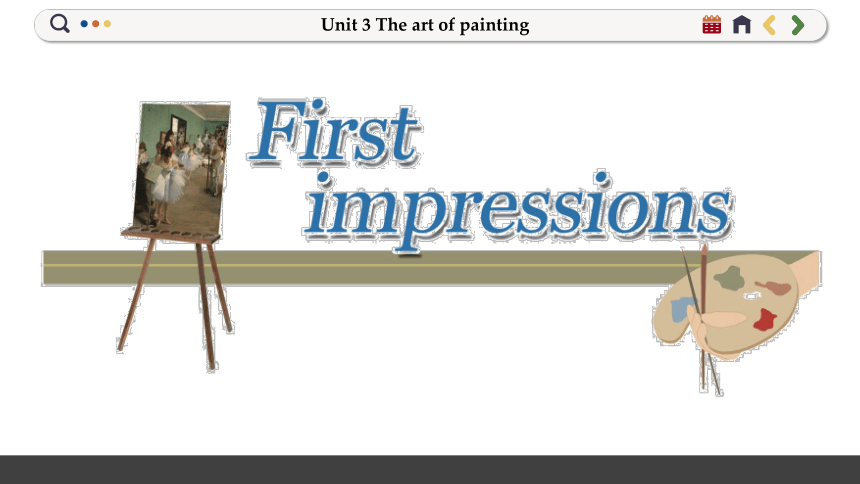
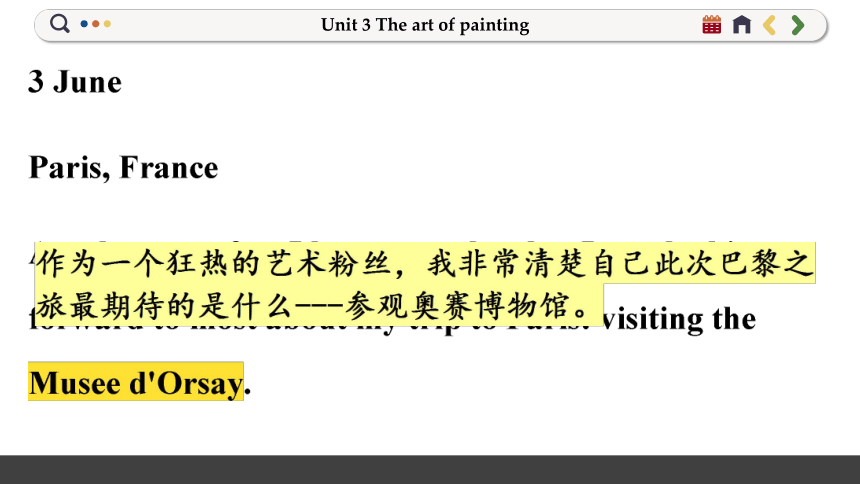



文档简介
(共129张PPT)
Unit 3
The art of painting
Welcome to the unit
The art of painting has a long history and there are different types of painting. Look at the paintings below and discuss the following questions in pairs.
绘画艺术有着悠久的历史,有着不同的绘画类型。看下面的画,然后两人一组讨论下面的问题。
1Which type do you think each of the paintings belongs to Why
2 What famous painters and paintings do you know about
Reading
Visiting museums is a very rewarding experience. The travel journal below is about a visit to an art museum. Before you read the travel journal, think about the following questions:
What do you think the travel journal talks about according to the title and the pictures
Why do people visit art museums
As I wandered through the lmpressionist gallery, I appreciated masterpieces like The Ballet Class and The Card Players.
Even though I had admired them hundreds of times on my computer screen, nothing could have prepared me for the wonder I felt when I finally laid eyes on the real thing.
While it was hard to pick a favourite painting out of so many amazing works, the artists who made the deepest impression on me were two of the greatest Impressionist painters, Claude Monet and Pierre-Auguste Renoir.
I could see from Monet's works that he was greatly inspired by nature.
In the last three decades of his life he painted mostly scenes from his garden. One of these scenes is shown in the famous piece Blue Water Lilies, which I studied for quite a while in the gallery.
I couldn't believe it when heard he did around 250 paintings of the same water lily pond, all in different colours and styles.
It is amazing that every time Monet studied this simple scene, he brought the pond's beauty to the canvas in a unique way.
Renoir, I noticed, preferred to paint scenes of everyday life. For me, the most interesting of his paintings is his 1876 masterpiece Dance at Le Moulin de la Galette.
which shows life in a busy neighbourhood of Paris on a Sunday afternoon.
When I saw it up close, I was struck by the small areas of light across the painting, and the way the soft edges of the figures seemed to mix together.
There's so much going on but so little clear detail. This effect makes the lively movement of the dance almost jump out at the viewer.
Although the paintings had very different settings, it was their similarities that stayed with me long after I left the Musee d'Orsay--similarities which can be seen throughout the Impressionists' paintings.
Monet and Renoir, along with other like-minded artists, sought liberation from the rules of the old style.
Everyday subject matter was the main focus of their works, as opposed to the history paintings that had traditionally dominated European art.
They employed free brushwork and used colours to show the effect of light on things, creating paintings that were far less realistic than the works that came before.
To me, these techniques are the essence of the Impressionist view of art.
Impressionist artists did not try to paint every detail in a scene--just a brief “impression” they had at that moment, burning with vivid colours and light, before it disappeared.
The Impressionists' vision inspired a whole new generation of Post-Impressionist painters such as Vincent van Gogh and Paul Gauguin, whose works are also displayed at the Musee d'Orsay.
It is also worthy of note that Post-Impressionist painters were not the only ones to be influenced by Impressionism-the movement has had a lasting influence on modern art, encouraging artists to look at the world from an entirely new point of view. It certainly left a lasting impression on me too!
A1 Read the travel journal and write down the main idea of each part in the chart below.
A2 Read the travel journal again carefully and decide whether the following statements are true (T) or false (F). Note down the sentences in the travel journal that support the true statements and correct the false statements.
1 The author was most impressed by Monet and Renoir.
T/F
2 Renoir's masterpiece Dance at Le Moulin de la Galette is very detailed T/F
3 The Impressionists tried to paint extremely realistic paintings T/F
4 The Impressionists showed the effect of light on things with colours. T/F
5 Van Gogh was influenced by Impressionism T/F
A3 In pairs, discuss the following questions.
1 Which of the following do you think is most likely to be an Impressionist painting Give your reasons.
I think the painting in the middle is most likely an Impressionist painting because it is probably anormal everyday scene for the painter.
The boat and its surrounding scene are just an impression of what the painter sawso they are not painted in clear detail--the soft edges of the boats , factory chimneys,
sea and sky seem to mix together This tells me that the painter used the Impressionist free brushwork technique.
The painter also used light and vividcolours to express his or her feelings.
2 If you were a tour guide of the Musee d'Orsay, how would you introduce the museum to the visitors
The Musee d'Orsay is a world-famous art museum in Paris, France. It is unusual because it was previously used as arailway station.
This museum is famous for its large collection of paintings from the Impressionist and Post-Impressionistmovements of the 19th century.
It also displays masterpieces from masters such as Claude Monet,Pierre-Auguste Renoir.Vincent van Gogh and Paul Gauguin.
A visit to the Musee d'Orsay allows visitors to look at and compare the differentstyles between the two art movements.
They can enjoy looking at the world from an entirely new point of view.
B1 The passage below is about the great painter Vincent van plete the passage with the correct forms of the words and phrases in the box below.
employ gallery display vision decade vivid
lay eyes on as opposed to
Vincent van Gogh was one of the most gifted artists of his generation.
He began working in an art (1)______________when he was 16 years old.
However, it was not until more than a (2) ________later that he started to seriously consider being an artist himself.
Van Gogh became depressed after he moved to London. In 1880, he took up painting, from which he drew much comfort. As he began to (3) ________talent for painting,
he realized that art was his true calling. He was very impressed by the artworks of the master painter Rembrandt when he (4) _____________them. In 1886, he moved to Paris to live with his brother, who introduced him to some Impressionist artists.
He began to form his own style, (5) ____________thick, unmixed paint. This resulted in (6) ____________colours, similar to those in the Impressionist paintings.
However, Van Gogh's works had strong lines (7) __________________colours the softer edges of Impressionism.
He made friends with Paul Gauguin, who shared the same (8) _______,and they became known as Post-Impressionists.
Although he was a genius, Van Gogh was not yet appreciated in the art world. He only sold one painting during his lifetime, but these days, his works are enjoyed bypeople around the world.
B2 The travel journal uses some words created from the same root word. Note the following words and think of more words from the same root word. Then fill in the table below with as many words as you can.
Tip
Establishing word families from root words
We can form some English words by adding suffixes to the same root word and together they form a word family. Establishing word families is an effective way to enlarge your vocabulary.
B3 The travel journal uses several words and structures to make comparisons. Find the examples of comparison in the travel journal and improve the sentences below.
Learn this
When describing either the similarities or the differences between two things, pay attention to the following expressions:
Describing similarities:
share, be similar to, like, as ... as
Describing differences:
as opposed to, in contrast to, be different from, than, unlike
The Louvre Museum is located in Paris. It houses more than 7,500 paintings ranging from the 13th century to 1848. The Musee d'Orsay is also located in Paris. It is mainly devoted to French art between 1848 and 1914.
Below is a blog entry about appreciating art in the digital age. Find the sentences that useverb-ing or verb-ed forms as predicatives and fill in the table below. The first ones have been done for you.
As I wandered in the National Gallery, I was amazed to see all the paintings I wondered at the skill of the artists, their use of colour and how they played with light and shade. I observed the brushwork they used to enhance their works.I enjoyed the whole experience--to be able to bathe my senses in this palace of human creativity.
It was surprising then to see so many people viewing important and precious artworks through their smartphones.
It might sound shocking, but they seemed more interested in taking photos and recording videos of art works than appreciating them with their own eyes.
How was it possible, I wondered, to truly appreciate the human touch of a great painting when it was reduced to a few million pixels
Looking at artworks through smartphones, I thought, was like trying to appreciate the countryside without being able to hear the birds sing, feel the breeze against my face or smell the flowers.
Moving slowly through the National Gallery, I was determined to keep my smartphone in my bag and appreciate each individual painting with the best camera in the world: my own eyes.
Verb-ing formsas predicatives lt was surprising then ...
Verb-ed formsas predicatives I was amazed to see all the paintings
Working out the rules制定规则
When used as the predicative, the verb-ing or verb-ed form is connected to the subject by a (1)______________
The (2) _________________form is often used to describe a thing or a situation;
the (3) _________________ form is often used to describe how a person feels.
B1 Complete the following sentences using the correct verb-ing or verb-ed forms of the verbs in the brackets.
1 The art show in town next week sounds______(appeal).
2 The old man was________ (amaze) by the paintings on show.
3 I find the soft colours in this painting very________ (relax).
4 The public were___________ (please) that they would have free access to these exhibitions.
5 The gallery staff looked very_________(tire) after working all day
B2 Below is a magazine article discussing measures taken by museums to encourage people to appreciate art with their own plete the article with the correct forms of the verbs in the box below.
prepare concern encourage satisfy surprise
You walk into a museum, stop in front of a masterpiece and wish to observe it up close. Instead of having a good view of it, however, you see nothing but raised arms and smartphones! Isn't it (1)_______________
Nowadays, the use of smartphones in museums continues to rise and art experts are (2) ____________about how to get people to truly appreciate artworks rather than simply take photos or record videos to post on social media. Some museums do not allow photography, which is less about camera flashes and more about encouraging people to enjoy the experience.
Amsterdam's Rijksmuseum, for example, has waged the Big Draw campaign, where visitors are encouraged to keep their smartphones in their pockets or bags and pick up paper and pencils instead. The national museum is hoping to help visitors discover and appreciate the beauty of art, architecture and history through drawing.
Some museums are also asking people to get (3)_____________before their visit by learning about the artworks first. Hopefully, with these measures, the experience of visiting museums will be more (4) _________ than simply recording everything with a smartphone.
There have already been some signs of improvement, which is very (5)_____________, but there's still a long way to go.
B3 In pairs, describe the paintings below using verb-ing and verb-ed forms as predicatives.
A1 Lisa has found a TV programme about the use of unusual materials in art. Watch the TV programme and finish the exercises below.
A1 Watch the TV programme and answer the following questions.
1 What do many creative artists use to make their artworks
————————————————————————2 What is Jane Perkins well known for
————————————————————————
3 What may an artist think of the things that we regard as rubbish
————————————————————————
4 What plays an important role in finding inspiration for your art from nature
————————————————————————
A2 Watch the TV programme again and complete the notes below.
Tip
ldentifying examples
The speaker often uses examples to help the audience understand the main idea better as well as to present the topic in a more interesting way
When you listen, pay attention to expressions that signal examples, e.g.
for example, for instance,such as.
B Lisa wants to create art using unusual materials and she has found some instructions for making unusual pictures. Read the instructions and pay attention to the structure.
How to make an amazing food portrait
Have you ever tried to make art out of food It's simple! Follow the steps below to see just how easy it can be to make bright, colourful portraits out of common food in the kitchen.
What you need
● A large piece of toast
● A variety of vegetables
● A knife
What to do
Step 1: Lay your toast out on the table
Step 2: Cut the vegetables to create different parts of the face. For example, red peppers can be used to make the mouth. Slices of garlic can be used to create teeth. Mushrooms can be used for eyes.
Step 3: Arrange the vegetables on the toast to create your portrait.
The best part about this art project is that you can eat it when you're done! But before you do, make sure you take a photo of it. That way, your art can live on long after dinner time!
Making a seashell picture
A day at the beach is a perfect start to this art project! Making pictures out of raw materials like seashells can be a fun challenge. Seashells come in many varieties, so there are endless possibilities for the kinds of pictures you can create.
Things you need
● Seashells
● A piece of card board
● Glue
Procedures
Step 1: Collect a bag of seashells from the beach
Step 2: Decide what image you want to create with your seashells and select seashells of different shapes and sizes.
Step 3: Arrange your seashells on the cardboard to create your image.
Step 4: Stick each seashell to the cardboard using glue. Display your seashell picture for your family and friends to see!
C In pairs, discuss how you will create a picture using unusual materials. Use the following questions and expressions to help you.
What image will you create
What materials and tools will you use for your picture
What steps will you take to create the picture
Expressions Describing procedures
first/firstly/to begin with/to start with
it is followed by .../the next step is ...
at the same time
as soon as ...
in the end/finally/lastly
D Write your step-by-step instructions for creating an unusual picture. Use your ideas from part C and the information in parts A and B to help you.
Instructions are the written information that tells readers how to do or use something.
This type of writing is supposed to include enough details so that readers can follow easily.
When writing step-by-step instructions for creating an unusual picture, you can follow the structure below:
>Start with a brief introduction explaining what kind of unusual picture will be created.
List the things needed to make the picture.
You can use a heading like “What you need”,“Things you need” or “Materials and tools”.
Give well-organized directions under the heading of “What to do”“Procedures” or “Directions”.
You can use numbers when listing the steps inorder.
Make sure to include key points and important warnings.
>Make your sentences short and clear
> Use the imperative mood or passive voice in each step.
Remember to check your writing after you finish and exchange drafts between you and your partner. Pay attention to the following aspects:
Zhang Zeduan's Qingming Scroll is a master work of Chinese art. Painted on a five-metre-long silk scroll, it offers an important insight into life in China in the 12th century. It is commonly believed that the city described in the painting is Bianjing (present-day Kaifeng), the capital of the Northern Song Dynasty.
The ancient scroll has survived the test of time remarkably well, and is currently housed in the Palace Museum in Beijing.
The scroll consists of three main sections. The first section presents a peaceful scene of rural life near Bianjing, featuring crop fields, a river winding through the landscape, and farmers hard at work.
The second section shows the riverbanks and the central bridge alive with activity as boats sail in and out of Bianjing.
Civilians can also be seen walking through the city gate in both directions. The third and final section pictures life inside the city itself. Here, hundreds of people from all walks of life, including butchers, hairdressers and government officials, can be seen going about their daily business.
The combination of these three sections gives the viewer an idea of what life was like for the people of Bianjing Zhang's amazing artistic technique is apparent all across the scroll. Using ink on silk, he creates realistic images of scenery, buildings and people, and displays are markable mastery of perspective.
The most impressive aspect of the painting, however, is probably Zhang's precise brushwork.
This well-developed ability, as well as the scroll's ambitious size, allows Zhang to show an enormous amount of detail-you could study the painting for hours and still discover something new.
Thanks to all this fine detail, the Qingming Scroll provides a comprehensive look at life during the Northern Song Dynasty.
It reveals a great deal about the12th-century Chinese customs, clothing, transportation methods, business practices, and a wide range of buildings, such as temples, teahouses and government structures.
At first sight, the overall scene of life in the capital city appears peaceful and cheerful. However, some critics suggest that on closer inspection, the painting actually exposes serious political and social problems. Some boats carrying food do not seem to belong to the government, which suggests that the government has lost control of food supplies and transportation.
Also in the painting are soldiers who appear to ignore their duties. There are some less obvious indicators of trouble too. For example, in the centre of the scroll, a boat is in danger of crashing into the bridge.
These sorts of details point to a crisis developing in the city.
In fact, the Northern Song Dynasty was in decline by this stage.
About twenty years after the painting was completed, it was overthrown.
Zhang's timeless scroll is an important example of realism in the history of Chinese paintings.
Its value is down not only to its great scale, artistic quality and attention to detail, but also to its representation of daily life.
Such is its worth that several later emperors even asked the most talented artists of their day to make copies of the scroll. Some of these copies are now regarded as precious works of art in their own right.
With the Qingming Scroll, Zhang made an outstanding contribution to Chinese art and greatly influenced generations of future artists.
The original scroll is still in one piece despite its age, but it is extremely delicate. Because of this, it is not often displayed to the public.
The last time it was on exhibition, crowds waited in line for hours for the rare chance to see the famous painting with their own eyes.
The public's continued enthusiasm about the Qingming Scroll, even after all these centuries, speaks volumes about the power of this historic piece of art.
A Write a summary of the essay. Use the following questions to help you.
What is the painting about
What technique does the painter use
What message does the painter want to get across
What is the value of the painting
B Museums may choose not to display some masterpieces to protect them from damage, but at the same time the public wish to have more access to them. How can we deal with this issue Make a list of possible measures.
A As a class, discuss painters from different cultures and time periods who represent various artistic styles. Then in groups, choose a painter to research.
B As a group, research your chosen painter. Use the ideas below to help you
Personal information
Famous works
Painting style
Achievements
C As a group, put together your information to make your poster. Use the example below to help you. Then present your poster to the rest of the class.
Answer the following questions to assess your performance. Then work in groups and exchange your answers with your partners.
1.What difficulty did you have when reading the travel journal about the visit to the Musee d'Orsay What are you going to do when reviewing the journal
2. Are you satisfied with your instructions on how to make an unusual picture Why or why not
3. What can you learn from the essay on the Qingming Scroll to help you appreciate other historic Chinese paintings
4. What is the best part of your poster about a painter Why
5. What new words have you learnt from this unit List some of them.*
6. What grammar have you learnt from this unit Make a sentence with thegrammar.*
7. What tips have you learnt from this unit Provide an example to show how one of them helps you with your learning.
8. How are you going to improve your overall performance Make an action plan.
Assess your learning of vocabulary and grammar by doing language practice on pages 69-70.
The website of the National Gallery in the UK provides a vast body of information about artwork exhibitions as well as artists. The site includes high-resolution pictures of art exhibits. Visit this site and take a virtual tour to learn more about the museum and the artworks in it.
The French Impressionists (1860-1900) is a book that covers interesting facts about Impressionism and important Impressionist painters.
It not only describes the beginning of the movement that produced some of the world's most famous painters, but also provides detailed analyses of artists‘ techniques and pictures of selected paintings.
Read it and find out what is behind the creation of Impressionist art
Unit 3
The art of painting
Welcome to the unit
The art of painting has a long history and there are different types of painting. Look at the paintings below and discuss the following questions in pairs.
绘画艺术有着悠久的历史,有着不同的绘画类型。看下面的画,然后两人一组讨论下面的问题。
1Which type do you think each of the paintings belongs to Why
2 What famous painters and paintings do you know about
Reading
Visiting museums is a very rewarding experience. The travel journal below is about a visit to an art museum. Before you read the travel journal, think about the following questions:
What do you think the travel journal talks about according to the title and the pictures
Why do people visit art museums
As I wandered through the lmpressionist gallery, I appreciated masterpieces like The Ballet Class and The Card Players.
Even though I had admired them hundreds of times on my computer screen, nothing could have prepared me for the wonder I felt when I finally laid eyes on the real thing.
While it was hard to pick a favourite painting out of so many amazing works, the artists who made the deepest impression on me were two of the greatest Impressionist painters, Claude Monet and Pierre-Auguste Renoir.
I could see from Monet's works that he was greatly inspired by nature.
In the last three decades of his life he painted mostly scenes from his garden. One of these scenes is shown in the famous piece Blue Water Lilies, which I studied for quite a while in the gallery.
I couldn't believe it when heard he did around 250 paintings of the same water lily pond, all in different colours and styles.
It is amazing that every time Monet studied this simple scene, he brought the pond's beauty to the canvas in a unique way.
Renoir, I noticed, preferred to paint scenes of everyday life. For me, the most interesting of his paintings is his 1876 masterpiece Dance at Le Moulin de la Galette.
which shows life in a busy neighbourhood of Paris on a Sunday afternoon.
When I saw it up close, I was struck by the small areas of light across the painting, and the way the soft edges of the figures seemed to mix together.
There's so much going on but so little clear detail. This effect makes the lively movement of the dance almost jump out at the viewer.
Although the paintings had very different settings, it was their similarities that stayed with me long after I left the Musee d'Orsay--similarities which can be seen throughout the Impressionists' paintings.
Monet and Renoir, along with other like-minded artists, sought liberation from the rules of the old style.
Everyday subject matter was the main focus of their works, as opposed to the history paintings that had traditionally dominated European art.
They employed free brushwork and used colours to show the effect of light on things, creating paintings that were far less realistic than the works that came before.
To me, these techniques are the essence of the Impressionist view of art.
Impressionist artists did not try to paint every detail in a scene--just a brief “impression” they had at that moment, burning with vivid colours and light, before it disappeared.
The Impressionists' vision inspired a whole new generation of Post-Impressionist painters such as Vincent van Gogh and Paul Gauguin, whose works are also displayed at the Musee d'Orsay.
It is also worthy of note that Post-Impressionist painters were not the only ones to be influenced by Impressionism-the movement has had a lasting influence on modern art, encouraging artists to look at the world from an entirely new point of view. It certainly left a lasting impression on me too!
A1 Read the travel journal and write down the main idea of each part in the chart below.
A2 Read the travel journal again carefully and decide whether the following statements are true (T) or false (F). Note down the sentences in the travel journal that support the true statements and correct the false statements.
1 The author was most impressed by Monet and Renoir.
T/F
2 Renoir's masterpiece Dance at Le Moulin de la Galette is very detailed T/F
3 The Impressionists tried to paint extremely realistic paintings T/F
4 The Impressionists showed the effect of light on things with colours. T/F
5 Van Gogh was influenced by Impressionism T/F
A3 In pairs, discuss the following questions.
1 Which of the following do you think is most likely to be an Impressionist painting Give your reasons.
I think the painting in the middle is most likely an Impressionist painting because it is probably anormal everyday scene for the painter.
The boat and its surrounding scene are just an impression of what the painter sawso they are not painted in clear detail--the soft edges of the boats , factory chimneys,
sea and sky seem to mix together This tells me that the painter used the Impressionist free brushwork technique.
The painter also used light and vividcolours to express his or her feelings.
2 If you were a tour guide of the Musee d'Orsay, how would you introduce the museum to the visitors
The Musee d'Orsay is a world-famous art museum in Paris, France. It is unusual because it was previously used as arailway station.
This museum is famous for its large collection of paintings from the Impressionist and Post-Impressionistmovements of the 19th century.
It also displays masterpieces from masters such as Claude Monet,Pierre-Auguste Renoir.Vincent van Gogh and Paul Gauguin.
A visit to the Musee d'Orsay allows visitors to look at and compare the differentstyles between the two art movements.
They can enjoy looking at the world from an entirely new point of view.
B1 The passage below is about the great painter Vincent van plete the passage with the correct forms of the words and phrases in the box below.
employ gallery display vision decade vivid
lay eyes on as opposed to
Vincent van Gogh was one of the most gifted artists of his generation.
He began working in an art (1)______________when he was 16 years old.
However, it was not until more than a (2) ________later that he started to seriously consider being an artist himself.
Van Gogh became depressed after he moved to London. In 1880, he took up painting, from which he drew much comfort. As he began to (3) ________talent for painting,
he realized that art was his true calling. He was very impressed by the artworks of the master painter Rembrandt when he (4) _____________them. In 1886, he moved to Paris to live with his brother, who introduced him to some Impressionist artists.
He began to form his own style, (5) ____________thick, unmixed paint. This resulted in (6) ____________colours, similar to those in the Impressionist paintings.
However, Van Gogh's works had strong lines (7) __________________colours the softer edges of Impressionism.
He made friends with Paul Gauguin, who shared the same (8) _______,and they became known as Post-Impressionists.
Although he was a genius, Van Gogh was not yet appreciated in the art world. He only sold one painting during his lifetime, but these days, his works are enjoyed bypeople around the world.
B2 The travel journal uses some words created from the same root word. Note the following words and think of more words from the same root word. Then fill in the table below with as many words as you can.
Tip
Establishing word families from root words
We can form some English words by adding suffixes to the same root word and together they form a word family. Establishing word families is an effective way to enlarge your vocabulary.
B3 The travel journal uses several words and structures to make comparisons. Find the examples of comparison in the travel journal and improve the sentences below.
Learn this
When describing either the similarities or the differences between two things, pay attention to the following expressions:
Describing similarities:
share, be similar to, like, as ... as
Describing differences:
as opposed to, in contrast to, be different from, than, unlike
The Louvre Museum is located in Paris. It houses more than 7,500 paintings ranging from the 13th century to 1848. The Musee d'Orsay is also located in Paris. It is mainly devoted to French art between 1848 and 1914.
Below is a blog entry about appreciating art in the digital age. Find the sentences that useverb-ing or verb-ed forms as predicatives and fill in the table below. The first ones have been done for you.
As I wandered in the National Gallery, I was amazed to see all the paintings I wondered at the skill of the artists, their use of colour and how they played with light and shade. I observed the brushwork they used to enhance their works.I enjoyed the whole experience--to be able to bathe my senses in this palace of human creativity.
It was surprising then to see so many people viewing important and precious artworks through their smartphones.
It might sound shocking, but they seemed more interested in taking photos and recording videos of art works than appreciating them with their own eyes.
How was it possible, I wondered, to truly appreciate the human touch of a great painting when it was reduced to a few million pixels
Looking at artworks through smartphones, I thought, was like trying to appreciate the countryside without being able to hear the birds sing, feel the breeze against my face or smell the flowers.
Moving slowly through the National Gallery, I was determined to keep my smartphone in my bag and appreciate each individual painting with the best camera in the world: my own eyes.
Verb-ing formsas predicatives lt was surprising then ...
Verb-ed formsas predicatives I was amazed to see all the paintings
Working out the rules制定规则
When used as the predicative, the verb-ing or verb-ed form is connected to the subject by a (1)______________
The (2) _________________form is often used to describe a thing or a situation;
the (3) _________________ form is often used to describe how a person feels.
B1 Complete the following sentences using the correct verb-ing or verb-ed forms of the verbs in the brackets.
1 The art show in town next week sounds______(appeal).
2 The old man was________ (amaze) by the paintings on show.
3 I find the soft colours in this painting very________ (relax).
4 The public were___________ (please) that they would have free access to these exhibitions.
5 The gallery staff looked very_________(tire) after working all day
B2 Below is a magazine article discussing measures taken by museums to encourage people to appreciate art with their own plete the article with the correct forms of the verbs in the box below.
prepare concern encourage satisfy surprise
You walk into a museum, stop in front of a masterpiece and wish to observe it up close. Instead of having a good view of it, however, you see nothing but raised arms and smartphones! Isn't it (1)_______________
Nowadays, the use of smartphones in museums continues to rise and art experts are (2) ____________about how to get people to truly appreciate artworks rather than simply take photos or record videos to post on social media. Some museums do not allow photography, which is less about camera flashes and more about encouraging people to enjoy the experience.
Amsterdam's Rijksmuseum, for example, has waged the Big Draw campaign, where visitors are encouraged to keep their smartphones in their pockets or bags and pick up paper and pencils instead. The national museum is hoping to help visitors discover and appreciate the beauty of art, architecture and history through drawing.
Some museums are also asking people to get (3)_____________before their visit by learning about the artworks first. Hopefully, with these measures, the experience of visiting museums will be more (4) _________ than simply recording everything with a smartphone.
There have already been some signs of improvement, which is very (5)_____________, but there's still a long way to go.
B3 In pairs, describe the paintings below using verb-ing and verb-ed forms as predicatives.
A1 Lisa has found a TV programme about the use of unusual materials in art. Watch the TV programme and finish the exercises below.
A1 Watch the TV programme and answer the following questions.
1 What do many creative artists use to make their artworks
————————————————————————2 What is Jane Perkins well known for
————————————————————————
3 What may an artist think of the things that we regard as rubbish
————————————————————————
4 What plays an important role in finding inspiration for your art from nature
————————————————————————
A2 Watch the TV programme again and complete the notes below.
Tip
ldentifying examples
The speaker often uses examples to help the audience understand the main idea better as well as to present the topic in a more interesting way
When you listen, pay attention to expressions that signal examples, e.g.
for example, for instance,such as.
B Lisa wants to create art using unusual materials and she has found some instructions for making unusual pictures. Read the instructions and pay attention to the structure.
How to make an amazing food portrait
Have you ever tried to make art out of food It's simple! Follow the steps below to see just how easy it can be to make bright, colourful portraits out of common food in the kitchen.
What you need
● A large piece of toast
● A variety of vegetables
● A knife
What to do
Step 1: Lay your toast out on the table
Step 2: Cut the vegetables to create different parts of the face. For example, red peppers can be used to make the mouth. Slices of garlic can be used to create teeth. Mushrooms can be used for eyes.
Step 3: Arrange the vegetables on the toast to create your portrait.
The best part about this art project is that you can eat it when you're done! But before you do, make sure you take a photo of it. That way, your art can live on long after dinner time!
Making a seashell picture
A day at the beach is a perfect start to this art project! Making pictures out of raw materials like seashells can be a fun challenge. Seashells come in many varieties, so there are endless possibilities for the kinds of pictures you can create.
Things you need
● Seashells
● A piece of card board
● Glue
Procedures
Step 1: Collect a bag of seashells from the beach
Step 2: Decide what image you want to create with your seashells and select seashells of different shapes and sizes.
Step 3: Arrange your seashells on the cardboard to create your image.
Step 4: Stick each seashell to the cardboard using glue. Display your seashell picture for your family and friends to see!
C In pairs, discuss how you will create a picture using unusual materials. Use the following questions and expressions to help you.
What image will you create
What materials and tools will you use for your picture
What steps will you take to create the picture
Expressions Describing procedures
first/firstly/to begin with/to start with
it is followed by .../the next step is ...
at the same time
as soon as ...
in the end/finally/lastly
D Write your step-by-step instructions for creating an unusual picture. Use your ideas from part C and the information in parts A and B to help you.
Instructions are the written information that tells readers how to do or use something.
This type of writing is supposed to include enough details so that readers can follow easily.
When writing step-by-step instructions for creating an unusual picture, you can follow the structure below:
>Start with a brief introduction explaining what kind of unusual picture will be created.
List the things needed to make the picture.
You can use a heading like “What you need”,“Things you need” or “Materials and tools”.
Give well-organized directions under the heading of “What to do”“Procedures” or “Directions”.
You can use numbers when listing the steps inorder.
Make sure to include key points and important warnings.
>Make your sentences short and clear
> Use the imperative mood or passive voice in each step.
Remember to check your writing after you finish and exchange drafts between you and your partner. Pay attention to the following aspects:
Zhang Zeduan's Qingming Scroll is a master work of Chinese art. Painted on a five-metre-long silk scroll, it offers an important insight into life in China in the 12th century. It is commonly believed that the city described in the painting is Bianjing (present-day Kaifeng), the capital of the Northern Song Dynasty.
The ancient scroll has survived the test of time remarkably well, and is currently housed in the Palace Museum in Beijing.
The scroll consists of three main sections. The first section presents a peaceful scene of rural life near Bianjing, featuring crop fields, a river winding through the landscape, and farmers hard at work.
The second section shows the riverbanks and the central bridge alive with activity as boats sail in and out of Bianjing.
Civilians can also be seen walking through the city gate in both directions. The third and final section pictures life inside the city itself. Here, hundreds of people from all walks of life, including butchers, hairdressers and government officials, can be seen going about their daily business.
The combination of these three sections gives the viewer an idea of what life was like for the people of Bianjing Zhang's amazing artistic technique is apparent all across the scroll. Using ink on silk, he creates realistic images of scenery, buildings and people, and displays are markable mastery of perspective.
The most impressive aspect of the painting, however, is probably Zhang's precise brushwork.
This well-developed ability, as well as the scroll's ambitious size, allows Zhang to show an enormous amount of detail-you could study the painting for hours and still discover something new.
Thanks to all this fine detail, the Qingming Scroll provides a comprehensive look at life during the Northern Song Dynasty.
It reveals a great deal about the12th-century Chinese customs, clothing, transportation methods, business practices, and a wide range of buildings, such as temples, teahouses and government structures.
At first sight, the overall scene of life in the capital city appears peaceful and cheerful. However, some critics suggest that on closer inspection, the painting actually exposes serious political and social problems. Some boats carrying food do not seem to belong to the government, which suggests that the government has lost control of food supplies and transportation.
Also in the painting are soldiers who appear to ignore their duties. There are some less obvious indicators of trouble too. For example, in the centre of the scroll, a boat is in danger of crashing into the bridge.
These sorts of details point to a crisis developing in the city.
In fact, the Northern Song Dynasty was in decline by this stage.
About twenty years after the painting was completed, it was overthrown.
Zhang's timeless scroll is an important example of realism in the history of Chinese paintings.
Its value is down not only to its great scale, artistic quality and attention to detail, but also to its representation of daily life.
Such is its worth that several later emperors even asked the most talented artists of their day to make copies of the scroll. Some of these copies are now regarded as precious works of art in their own right.
With the Qingming Scroll, Zhang made an outstanding contribution to Chinese art and greatly influenced generations of future artists.
The original scroll is still in one piece despite its age, but it is extremely delicate. Because of this, it is not often displayed to the public.
The last time it was on exhibition, crowds waited in line for hours for the rare chance to see the famous painting with their own eyes.
The public's continued enthusiasm about the Qingming Scroll, even after all these centuries, speaks volumes about the power of this historic piece of art.
A Write a summary of the essay. Use the following questions to help you.
What is the painting about
What technique does the painter use
What message does the painter want to get across
What is the value of the painting
B Museums may choose not to display some masterpieces to protect them from damage, but at the same time the public wish to have more access to them. How can we deal with this issue Make a list of possible measures.
A As a class, discuss painters from different cultures and time periods who represent various artistic styles. Then in groups, choose a painter to research.
B As a group, research your chosen painter. Use the ideas below to help you
Personal information
Famous works
Painting style
Achievements
C As a group, put together your information to make your poster. Use the example below to help you. Then present your poster to the rest of the class.
Answer the following questions to assess your performance. Then work in groups and exchange your answers with your partners.
1.What difficulty did you have when reading the travel journal about the visit to the Musee d'Orsay What are you going to do when reviewing the journal
2. Are you satisfied with your instructions on how to make an unusual picture Why or why not
3. What can you learn from the essay on the Qingming Scroll to help you appreciate other historic Chinese paintings
4. What is the best part of your poster about a painter Why
5. What new words have you learnt from this unit List some of them.*
6. What grammar have you learnt from this unit Make a sentence with thegrammar.*
7. What tips have you learnt from this unit Provide an example to show how one of them helps you with your learning.
8. How are you going to improve your overall performance Make an action plan.
Assess your learning of vocabulary and grammar by doing language practice on pages 69-70.
The website of the National Gallery in the UK provides a vast body of information about artwork exhibitions as well as artists. The site includes high-resolution pictures of art exhibits. Visit this site and take a virtual tour to learn more about the museum and the artworks in it.
The French Impressionists (1860-1900) is a book that covers interesting facts about Impressionism and important Impressionist painters.
It not only describes the beginning of the movement that produced some of the world's most famous painters, but also provides detailed analyses of artists‘ techniques and pictures of selected paintings.
Read it and find out what is behind the creation of Impressionist art
同课章节目录
- Unit 1 Food matters
- Welcome to the unit
- Reading
- Grammar and usage
- Integrated skills
- Extended reading
- Project
- Unit 2 The Universal Language
- Welcome to the unit
- Reading
- Grammar and usage
- Integrated skills
- Extended reading
- Project
- Unit 3 The art of painting
- Welcome to the unit
- Reading
- Grammar and usage
- Integrated skills
- Extended reading
- Project
- Unit 4 Exploring poetry
- Welcome to the unit
- Reading
- Grammar and usage
- Integrated skills
- Extended reading
- Project
